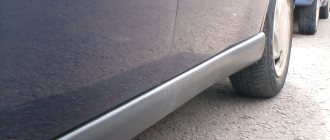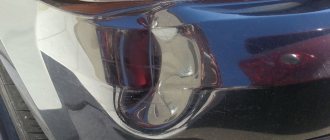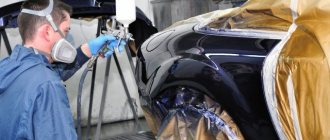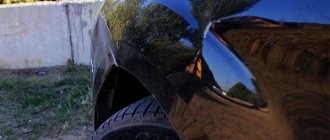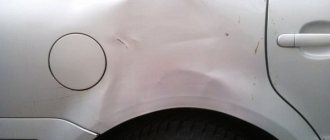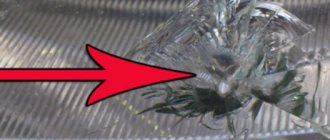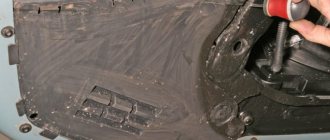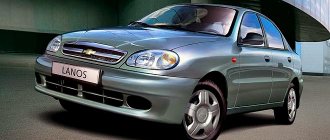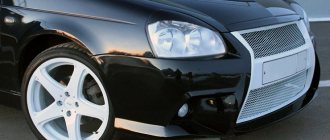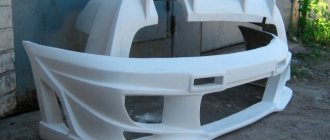In this article I will tell you how to fix a dent on a bumper. Let's look at several ways to heat a bumper and the correct sequence for straightening a dent.
Pressing from the reverse side can be considered the easiest way to straighten a dent. However, for a plastic bumper, if you get to the back side or even remove it, it will be difficult to push out the dent due to the rigidity of the plastic. Extruding a dent on a plastic bumper is made easier by heating it. The rules given in this article will help you straighten a deformed bumper without causing additional damage. It is impossible to restore a bumper to new condition by simply pushing out the dent from the inside. Usually scratches and small creases remain, which require further puttying, priming and painting. However, if everything is done correctly, the bumper will look 90% better even without painting.
Preparing the bumper for repair
- Wash and dry the damaged part of the bumper before repairing.
- It is not always necessary to remove the entire bumper to fix a dent. You can remove the protection from below or loosen the fender liner to gain access to the back of the dent. Thus, it will be more convenient to press on the dent from the back side when the bumper is fixed.
- Again, if the bumper is removed, it becomes possible to heat the back side of the bumper. This makes heating more even.
Types of repairs
The range of restoration work is selected taking into account the type of material and the nature of the failure. The most common restoration options are:
- Removing scratches. Quite often, car bumper repair is limited to simple paintwork. Shallow scratches can be removed by painting and sanding. If the grooves are deep, you will need to partially level the surface so that the paint lays evenly and securely.
- Repairing damage. With severe mechanical damage, large chips or even breakdowns often form. In such cases, restoration will require highly complex work. Activities include edge scraping, backing fusing, wire mesh application, plastic fusing, priming, painting and polishing. The scope of work differs depending on the type of bumper and the nature of the damage.
- Bumper crack repair. Such defects are easier to eliminate than breaks. Often, restoration requires simply melting the edges of the damaged area and bonding them together at high temperature. After this, standard straightening operations are performed.
- Straightening dents. Plastic is a soft material. In winter, it will break under mechanical stress, but on hot days a dent often forms at the site of the impact. If the paint layer has not been damaged, restoration will only require correcting the defect. Sometimes just applying a little force on the back side is enough.
In many cases, repairing plastic car bumpers is easy to do yourself. If you have the skills and special tools, you can eliminate even complex flaws. True, it is necessary to take into account a number of problems that are difficult to avoid without experience.
Bumper heating
- To straighten a dent, you need to properly remove all the stress created by the deformation. This can be done by heating the plastic and applying the right amount of force. When heating a dent, you also need to heat 10–15 cm around it. By doing this, you relieve the tension in the area around the dent created by the impact.
- For heating, you can use available means such as a hair dryer or boiling water. Other means that help to more evenly heat the entire deformation zone at the same time are exposure to an infrared lamp (drying), as well as dipping the damaged part into a bath of hot water. We will consider all these means below.
- Consider the thickness of the plastic before applying heat to the dent. On some modern cars, the plastic is very thin and can easily overheat.
- If the plastic is not hot enough, the deformation will not ease and, when straightened, will return. On the other hand, if you overheat the plastic, it will become much more difficult to repair. It will stretch unnecessarily when pressed. When plastic is overheated and on the verge of melting, strength and elasticity deteriorate as it cools. Therefore, it is important to heat the bumper to the correct temperature and not overdo it.
- There are cases when stronger heating of the plastic is necessary in certain places. For example, to remove folds formed during deformation.
- When using a hair dryer, you need to heat the bumper until the surface is hot when touched. The ideal temperature for heating the bumper is between 160–200 degrees. When heating the bumper, you need to hold the hair dryer nozzle close to the surface to control the heat, but no closer than 10 cm. Move the hair dryer evenly at a moderate speed to properly warm up the plastic. Excessive heat may cause the paint to bubble. At this temperature, the plastic can change shape with moderate force. Don't forget that you need to heat not only the dent, but also the area around it. When using a hair dryer, use its highest setting. A hair dryer is best used on medium settings. If the dent is large, then you can use two hair dryers. It is better to have a second person help.
- When using hot water to straighten a dent, you need to boil a full kettle or pan of water. Hot water will make the plastic more flexible. Such heating will not last long, so you need to do everything very quickly. You need to get to the other side and press. We will look at dent correction in more detail below.
If a dent has formed on the ribs of the bumper, then after heating you need to press directly on the ribs.
- To straighten the dent, the bumper can be immersed in a bath of hot water (80–90 degrees Celsius) for several minutes. Part of the dent may return on its own, but the rest must be straightened by hand after removal from the bath. To remove any remaining deformation, you can apply local heat with a hairdryer set to the desired temperature.
- Infrared drying can be used to heat the damaged area. Drying can be considered a less accessible heating method, but effective. It is used in body repair and car painting. Drying softens a large area, and the dent becomes pliable and all stress is relieved. No matter how deep the dent is, it will heat up evenly and return easily without significant effort. In addition, if the plastic is well heated, there is less chance of small cracks appearing in the paint after straightening.
What you need to repair a bumper
To properly repair a plastic bumper without painting, you will need the following tools or materials:
- hair dryer It is very important that it produces the necessary power, so it is best to give preference to industrial models;
- boiling water It can be used together with a hairdryer or instead of it (or you don’t have to use it if you have a hairdryer). To make repairs without painting, you will need from one to several liters - it all depends on the size, depth and complexity of the dent being repaired;
- a straight metal object with a blunt end . This could be an ordinary screwdriver or similar tool;
- gloves . The most ordinary ones will do. Their task is to protect the master’s hands from accidental exposure to boiling water or hot air;
- can of compressed air.
How to fix a dent on a bumper?
- When the desired temperature has been reached, you can begin squeezing out the dent. For large dents and small waves, a gloved hand works well. For sharper dents, creases, or to restore edges, a wooden block can be used. If you can’t get your hand through, use a long block with a rag wrapped around it.
- The plastic cools down quite quickly, so you need to maintain the temperature to keep it pliable.
- When straightening a dent, it is best to start from the outer part of the dent and work towards the deepest part. The deformation stress is concentrated at the edges. Relieving the tension will allow the deepest part of the dent to straighten out easily. If the area with stiffening ribs is deformed, then you need to press directly on these ribs.
Sometimes a shallow dent in a bumper can be straightened out by applying heat and then applying pressure to the raised areas formed along the edges of the dent. This way, you don't even need to push out the dent from the back side.
- Straightening out a dent sometimes requires direct, steady pressure. In other cases, smoothing may be required. There is no need to be afraid to press with force, but if the plastic does not give in, then you need to heat this area some more.
- Some dents are easier to fix than others. Sometimes several editing steps are required.
- You can use a hairdryer to spot heat the remaining creases or holes.
- Once you have straightened the dent to the desired shape, holding it from the back side, fix the result with a wet rag. It will cool the bumper and the shape will remain unchanged. The rag should be applied around the dent.
- After straightening the dent, the bumper can be put back in place and the remaining defects can be polished, or a brush can be used to touch up scratches. Deeper scratches and uneven surfaces require puttying, priming and painting.
How to fix a dent
To properly repair a dent on a front or rear plastic bumper without painting, you must follow the following algorithm:
- Dismantle the part . Typically, both front and rear bumpers can be easily removed. This will help you a lot when working, because most likely you will need an approach to both the external and internal sides of the part.
- Thoroughly wash and dry the part being repaired. The entire surface of the damage must be clean and dry on both sides. There should be no traces of dirt, mildew or rust on the bumper.
- Gradually heat the deformed part of the plastic bumper using a hairdryer or pour boiling water over it. In this case, the entire area should be heated as evenly as possible. It should be remembered that plastic should never be brought to a state in which it begins to melt. Otherwise, repairing the bumper without subsequent painting will simply be impossible.
Using a hair dryer to remove a dent on the bumper
- As the bumper heats up, you need to gradually press the dent from the back side with rotating movements. For this you will need a blunt metal object.
You should take into account the fact that heated plastic is very malleable, and therefore in no case should you put too much pressure on only one part of the dent - it should all be pulled out evenly.
If a dent has formed where the rib of the bumper passes, then first you need to level it. After this, it will be easier for you to restore the rest of it. In some cases, the plastic itself will begin to return to its place under the influence of temperature. In such a situation, you don’t even need to use a screwdriver or similar object - it will be enough just to heat it evenly and make sure that it does not start to melt. The ability or inability of plastic to return to its place on its own depends on its type and structure.
DIY bumper repair
- After the bumper repair has been completed and the dent has been completely pulled out, it is best to cool the area of deformation using a can of compressed air or just a wet rag. The thing is that some types of plastic bumpers have a “memory” of shapes. And if the repair is carried out several weeks or even months after the damage was sustained, then during this time the plastic bumper could “remember” the new shape, and 5-10 minutes after the repair the dent will begin to appear again. Using a wet cloth or compressed air will secure the material in its new position.
- After the part has completely cooled, it can be installed in its original place.
If you did everything correctly, you can consider that removing a dent from a plastic bumper without painting was successful.
Author: Baranov Vitaly Petrovich
Education: secondary specialized. Specialty: car mechanic. Professional diagnostics, repair, maintenance of passenger cars of foreign production 2000-2015. Extensive experience working with Japanese and German cars.
conclusions
The design of modern car bumpers and the technical properties of the materials used for their manufacture make it possible to carry out most repair work yourself. To do this, you need to be careful and careful not to use unnecessary physical force and damage the bumper. However, complex dents should be entrusted to the attention of professionals, since they may be located in inconvenient places, or their independent removal may lead to failure of this element of the car’s structure.
Source
How to straighten a damaged bumper with your own hands: home methods
One of the common situations, especially in the winter season, is the appearance of dents on the car bumper. They arise in the process of “collision” with snowdrifts. Even a small interaction like this can result in a decent amount of money that you will have to pay at a car service for its restoration. But it’s easy to straighten a plastic bumper with your own hands. You need to purchase the necessary tools and become familiar with the stages of the work.
Diagnostics and preparation before repair
To repair horizontal or vertical blinds, you must first correctly determine the cause of the breakdown and the very essence of the problem. Different defects may exhibit similar “symptoms,” so the complexity and costs of correcting the defects depend on the correctness of the “diagnosis.”
In the case of expensive products, it is best to seek help from service centers. Specialists will correctly determine the essence of the problem and perform all necessary repair actions.
The cause can be identified by the following signs:
- Complete rotation of the vertical panels around their axis or poor closing of the sashes indicates a malfunction of the rotating mechanism.
- The slats have obvious damage - breaks or bends, which can be determined when inspecting the curtains.
- If the curtains react poorly to changes in the position of the cord or do not respond at all, then most likely it is torn or stretched.
Once the problem is identified, the product will need to be prepared for repair. To do this, you need to dismantle the cornice or remove all parts from it to the extent possible that it is damaged. Then fix the damage and assemble everything in the opposite direction, maintaining the desired mounting order.
How to sand, putty and paint a bumper
When solving this issue, it is best to seek help from specialists from a car service center, because this process requires special care and accuracy from a person. The prices for providing such a service are quite low. Almost anyone can find a few rubles to paint their bumper. However, this procedure can be performed independently, without the help of third parties.
To do this, you just need a brush and special paint, which can be purchased at any auto parts store. Based on all of the above, we can conclude that a small dent formed on a car bumper can be quite easily corrected on your own. After reading this article, everyone will be able to cope with a similar problem.
Preparation stage
To get rid of a dent on a plastic bumper, it is first recommended to properly prepare. It is important to understand that the resulting dents can be shallow or deep. In one situation the paint layer is damaged, in another it is not. Therefore, before starting work, experienced specialists recommend carefully studying the future scope of work. It is not always the case that the situation allows for routine dent removal, as cracks, chips and other serious damage occur. Simple straightening will not have any effect. Restoration will require serious time and financial costs. In practice, it turns out that restoring such a body element will cost more than buying a new bumper. When there are minor dents on the bumper that do not result in cracks or chips, then feel free to proceed with straightening.
Tools and materials
A dent in a plastic bumper can be easily repaired if you use the right quality tools. Moreover, when doing such work with your own hands, it is important that the product being repaired is carefully prepared in advance. As for the complexity of the tools needed to straighten a dent, in many cases you can use simple tools that do not require investing a lot of money.
To repair a plastic bumper, ridding it of dents, you must prepare the following materials and tools in advance:
Set of materials and tools
Before straightening the bumper, it is recommended to assemble the necessary set of tools and materials. Without them, it is simply impossible to align the element. Since every car owner wants to achieve a high level of quality, it is impossible to do without preliminary preparation. Dents can be repaired on plastic bumpers. They can be deformed in the required and controlled direction. And here it is not at all necessary to use expensive and complex equipment. A standard garage bumper straightening kit includes several of the most important components:
It is possible that we will have to somewhat expand the existing set of tools and materials. Here everything depends on the specific situation. Quite often, after straightening a plastic part, it has to be additionally tinted. Therefore, you will need to prepare a kit to restore the paint layer on the bumper.
Sanding, puttying the bumper and preparing for painting
When sanding your bumper, don't be afraid to use coarse sanding paper (P80 or P60). This paper will remove paint and cut off small raised areas that are otherwise difficult to remove. Puttying and sanding with a finer abrasive will help get rid of rough scratches in the future. To slightly smooth out the lint that forms after sanding with coarse sandpaper, you can use a gas torch. You need to move the burner quickly so as not to overheat the plastic. You can read more about the technology of puttying a plastic bumper in the article “technology of puttying and painting plastic bumpers.”
Repairing complex dents
It happens that deeper dents appear on the bumper than those left after contact with snowdrifts. The reasons for their occurrence can be different, ranging from children playing with a ball to road accidents. To level out such a dent, it is not at all necessary to contact specialists. All work can be done with your own hands.
There is an effective and simple method. To straighten a dent, you will need a powerful hair dryer, which heats the area around the damage for a couple of minutes. Next, the heated dent is sprayed with a can of compressed air until traces of frost from the liquefied air appear. Afterwards, you should wait for the frost to disappear and observe the surface straightening on its own. All that remains is to wipe the dent until a natural shine is formed.
So, you can always fix a dent that appears on the bumper with your own hands, which will save significant money.
Source
Complex dents
Working with plastic bumpers is quite common and is often done at home or in the garage. This is not difficult when the structure is really made of good plastic and does not have serious deformations. When the products are made of metal, then the work of fixing the dent becomes much more difficult.
When deep deformations form on a plastic element, it is best to use a standard correction method. The motorist will need to take a powerful hair dryer and heat the area around the damage. Then, after heating, the damaged element must be quickly cooled using a can of compressed air. The structure is cooled until frost appears on the surface. Now you need to wait and not rush anywhere. If the plastic used to make a car bumper actually has shape memory, it will soon return to shape. It also happens that the damage to the plastic bumper turns out to be much more serious and severe, resulting in cracks and chips. Experienced motorists and car service specialists strongly do not recommend trying to restore such a structure on your own. It is worth visiting a good workshop where professionals in the field of body work work.
Taking into account the design features of modern car bumpers, the materials used and the capabilities of the car owner himself, it will not be difficult to carry out a number of repair and restoration work at home. To achieve the desired positive result, you should work as carefully and carefully as possible. Often, motorists are simply in a hurry and put in more effort than is actually necessary. This increases the risk of making everything worse, rather than solving the problem of a deformed bumper with your own hands. If the dents are complex, chips and cracks have formed, it is not recommended to take risks and try to fix the defects yourself. Here, the best solution would be to visit a good auto repair shop that specializes in body work, including restoration of damaged bumpers.
Carefully study the rationality of such a decision. Repairing a bumper is not always more profitable than simply replacing it with a new one. Think and consult with specialists how much restoration will cost, and how much a similar new bumper costs along with installation. Improper restoration in violation of technology and instructions often leads to the final breakdown of the car bumper. Attempts to save even on the services of masters become a reason to pay more. First, the vehicle owner spends money on restoration on his own, but nothing works out, and he has to pay again. Either for the services of specialists, or for purchasing a new bumper for your car.
By weighing all the facts and making the right decision from the beginning, you will be able to significantly save time, money and other equally necessary and important resources.
Source
